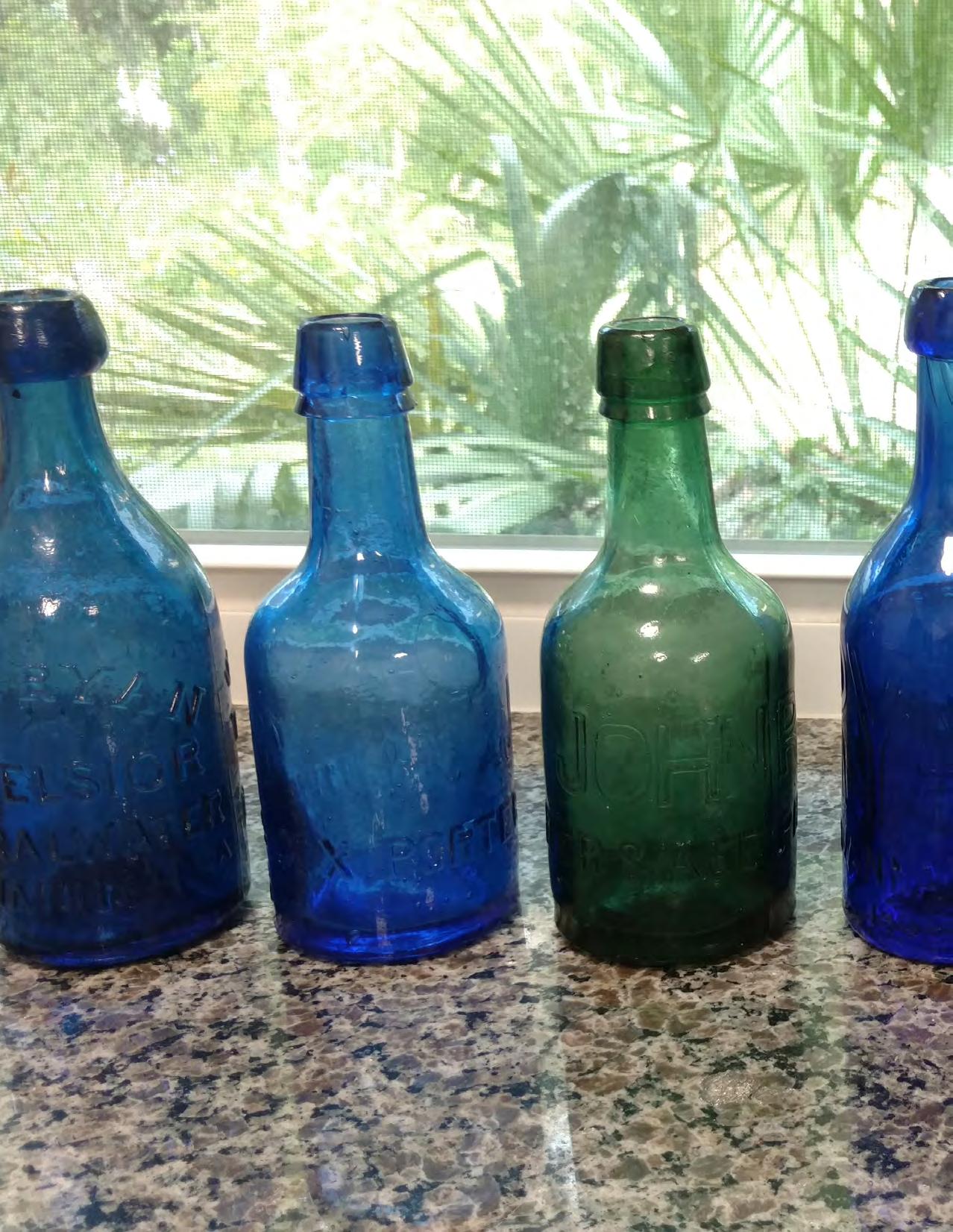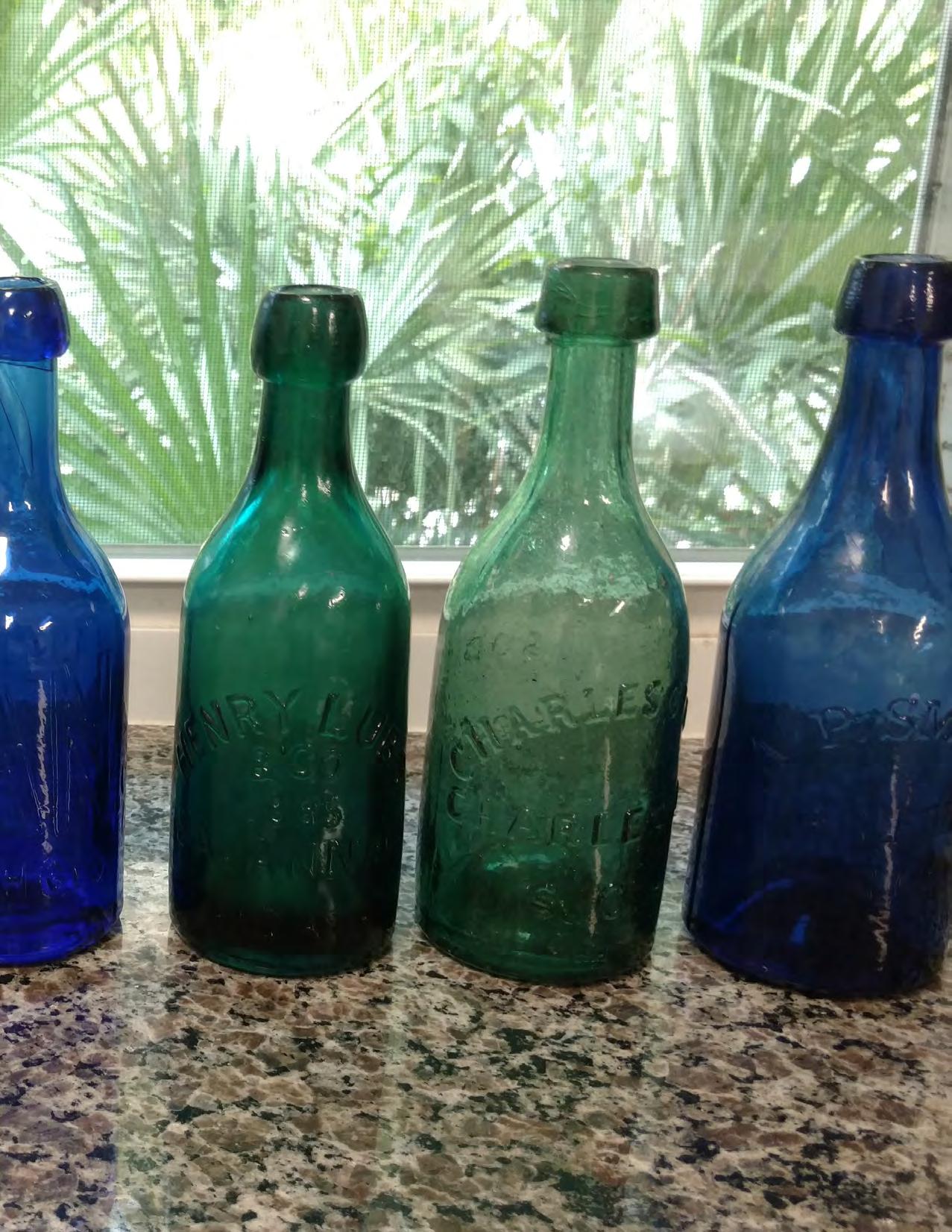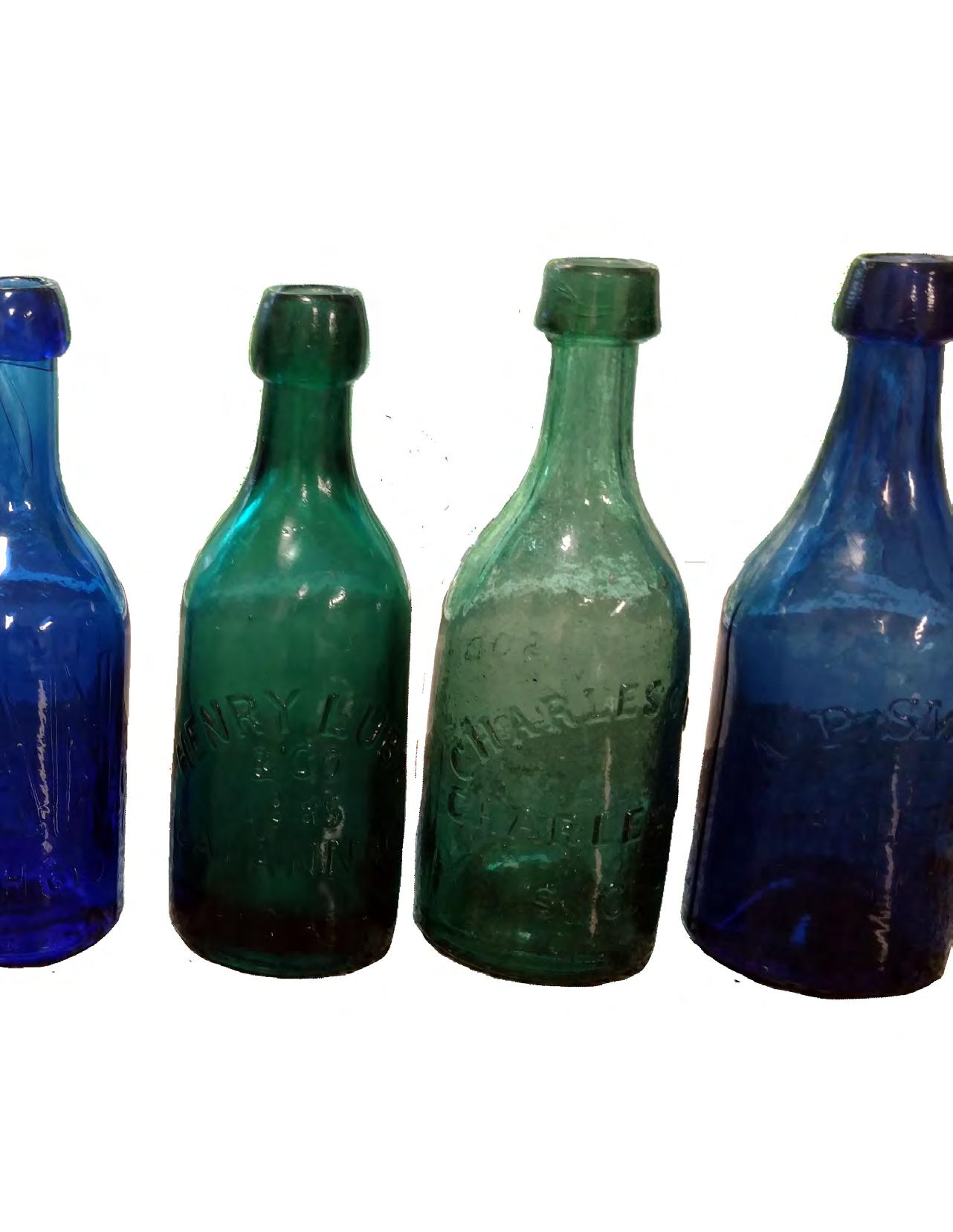
6 minute read
Windowsill Bottles - Reflections on a Collection by David Kyle Rakes
38 38 Septem Septem er er - - Octo Octo er er 2020 2020 B B ottles ottles and and Extras Extras Windowsill Bottles
Reflections on a Collection

By David Kyle Rakes
Windowsill bottles from David's soda bottle collection.
Sometimes I just sit in my study and stare at my collection of brightly colored glass sodas lined up along the windowsill, the sunlight striking the cobalt blues and greens and making all glow in strobe-like bands. They certainly get my attention.
Lately, I have become curious as to why I find those colored sodas so enjoyable to look at and collect. One reason is that the bottles are mouth-blown and date to more than 150 years old. The glass works also saw fit to emboss the names of the bottlers, the ciities where they were located and even the dates when their businesses were established.
But its their colors that make them most attractive as collectibles. I suspect my reasons are shared by those who collect other antique bottles such as historical flasks, bitters, patent medicines, inks and poisons. Scientists note that our sensory perception to color is fundamental on how we perceive the world and may be the strongest reason why there are so many who collect antique
glass containers. My collection of seven windowsill bottles is presented here for a brief examination, just to show you my zeal and appreciation for collecting glass bottles. They are all cylindrical, about 7 inches tall and 2-1/2 inches wide. Three quarters of the way up the bottle, the glass gradually curves and tapers into a neck that terminates with a round blob of glass or a collared top. My examples include a dark blue John Ryan mineral water with arched letters, light blue and forest green John Ryan Philadelphia XX Porter & Ales, 1866, and a cobalt blue John Ryan mineral water with 2-inch letters and dated 1859. All of those are from Savannah, Ga. The remainder of my collection consists of a teal-green Henry Lubs & Co., 1885, Savannah, Ga., a forest green Charles Clark and deep blue A.P. Smith, both from Charleston, S.C.


The bottles are in excellent condition, with some sporting bubbles in the glass, making them even more attractive. The first John Ryan mineral water and the two Charleston bottles are much older than the others, with iron (sometimes called graphite) pontil marks on the bases. That technique was used by glass factories from 1845 to 1865. The others have smooth bases dating their period of manufacture to after 1865. Learning how and when the bottles were blown added to my overall enjoyment of collecting.
Here are three outstanding cobalt sodas of A. P. Smith and John Ryan (Photo courtesy of Mike Newman)

Another interesting aspect of collecting bottles is researching historical information on the bottlers’ backgrounds. Such details can be found through internet sources, online archives from newspapers in the bottlers’ hometowns and business directories published in many cities.
I have selected just one bottler to show how knowledge of his history can invigorate the enjoyment of antique bottle collecting. John Ryan may not have been the earliest soda water bottler in the South, but he certainly is the best-known of all of America’s early soda water bottlers. Research over many years by collectors have painted an interesting picture of this Irish businessman
In 1852, Ryan established his Excelsior Bottling Works in Savannah on West Broad and Bay streets and later in 1869 he changed his location behind the historical Downing Mansion on Broughton Street. That home was well known for being the headquarters of the general prevost during the British occupation of the city during the American Revolution. Ryan had the mansion restored and rebuilt its outbuildings where he established his soda water factory. ously injured” Ryan and an employee. The resilient Ryan recovered physically as well as financially and was able to rebuild his factory on the site. By 1870, the business was in its 18th year and Ryan’s employees had swelled to six men. He also had four women servants in his home which was occupied by his wife Margaret, also Irish and from NYC. They had become the parents of four daughters (Mary, Agnes, Annie and Emma) and a son, Robert. The real estate of his property was valued at $35,000.
However, all was not so peachy for Ryan as a businessman during the Civil War. Renewal of his supply of bottles from the Philadelphia Glass Works was halted as well as the northern source for the cork closures. In 1865 after the end of the war, Ryan was on trial for treason for his part in procuring Negroes and leasing them to Confederate forces. His trial took place in the U.S. Courtroom in the custom house in Savannah. But Ryan had become a prominent Savannah citizen and was an officer in the city fire department and held memberships in the Literary Association, Hibernian Hall Association, Mutual Loan Association and Liquor Dealers Mutual Protection Association, to name a few. Trial details are not known, but he was acquitted.
Three nice examples of John Ryan sodas (Photo courtesy of Mike Newman)

established Georgia branches in Augusta, Atlanta and Columbus. A key to his success was due to the variety of quality products he sold. Included were drugs called Citrate of Magnesia and Essence of Jamaica Ginger, He supplied syrups such as raspberry, strawberry and lemon as well as cordials in the flavors of rose, peppermint and anisette. Other products were the essence of peppermint, ginger ale, cider, Stoughton Bitters, Philadelphia and imitation London Porter, scotch ale, lager beer and, of course, soda water.
An incredible 130 different bottle types were produced to keep up with the supply and demand. Many of his products were delivered throughout the city in horse-drawn wagons. Bottles were expensive and despite Ryan’s embossed warning that “This Bottle is Never Sold and Must Be Returned,” many were pirated by other businesses. Technically, one bought the beverage, but not its container. Ryan also offered $25 rewards for evidence leading to the arrest and conviction of anyone stealing and using his bottles.
Ryan retired in 1879 and died in 1885. He was buried in the Catholic Cemetery. His will left his property to his family. It consisted of “one horse and buggy, two shares of South Western Railroad stock and some soda water apparatus.” His Excelsior Bottling Works lived on in Augusta. Edward Sheehan, an Irish immigrate who was employed by Ryan in Savannah before a yellow fever epidemic forced him and his family to leave the port city, served as manager of Ryan’s branch. After Ryan’s passing, Sheehan named his own soda water bottling works Excelsior and he was known as the oldest living independent bottler by the time of his death in 1922 when he was 71.
So here I sit in my study, enjoying the brilliant colors of my seven soda water bottles from another era. And thinking of all the early manufacturing processes employed by the early glass works. It’s no wonder I remain fascinated.
SOURCES: Savannah Sodas, An Illustrated List, by Russ Butler, Havana, Fla., 1998. “Savannah Bottler John Ryan’s Fame has spread across the United States,” by Bill Baab, Sept.-Oct. issue of Bottles and Extras, 2016; John Ryan, George Ebberwein et al, by Rita H. DeLorme, Southern Cross Catholic Newspaper, Sept. 21, 2006; Savannah, Ga., Chatham County, Census Returns for 1860, 1870, 1880; Works Progress Administration books, Savannah Newspaper Digest, Savannah Morning News; John Ryan Historical Marker in Savannah; Savannah River Plantations, Savannah Writer’s Project, Mary Granger, editor, Georgia Historical Society, 1947, Page 112; “You can thank your fruit-hunting ancestors for your color vision, by Michael Price, Science Magazine, 2017; “How color affects dfood choice," by Costa Magonlas, UNLV, digital swcholarship, 2009.








